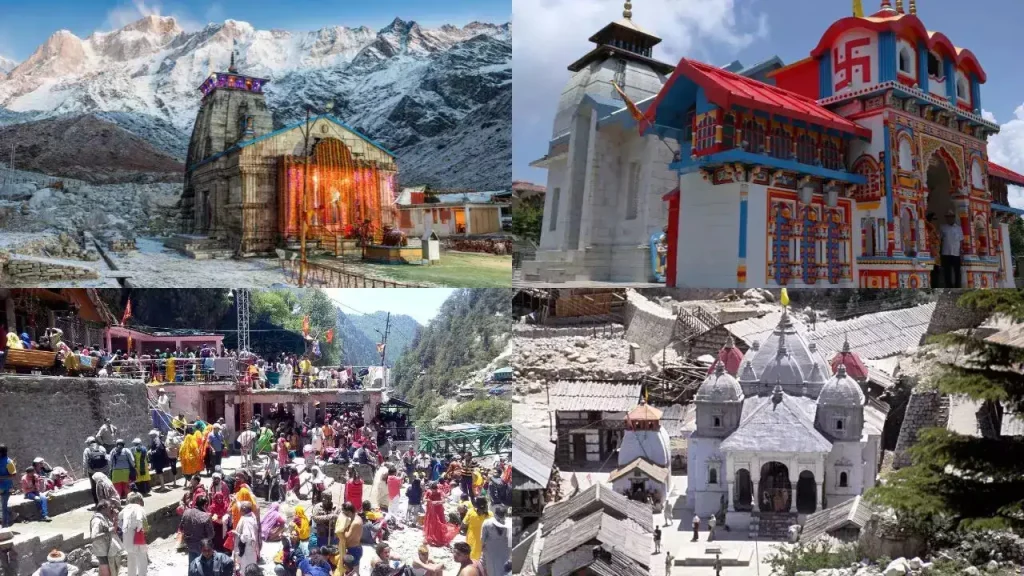Discover the Best Time to Visit Badrinath and Kedarnath Yatra in 2025. Plan your Char Dham Yatra with ideal weather, crowd insights, and travel tips for a divine experience.
Badrinath and Kedarnath, two of the most sacred pilgrimage sites in India, attract millions of devotees every year. Located in the Garhwal region of Uttarakhand, these temples are part of the Char Dham Yatra, a spiritual journey that holds immense religious significance. Planning your visit to these revered shrines requires knowledge of the best time to go to ensure a smooth and spiritually fulfilling experience. In this guide, we will walk you through the best time to visit Badrinath and Kedarnath in 2025, considering factors such as weather, crowd, and the Yatra season.
- 1. Understanding the Char Dham Yatra
- 2. The Char Dham Yatra Opening and Closing Dates
- 3. Best Time to Visit Badrinath and Kedarnath
- 4. Why May to June and September to October Are Ideal
- 5. Travel Tips for Visiting Badrinath and Kedarnath
- 6. Conclusion
- FAQs
- What are the opening dates for Badrinath and Kedarnath in 2025?
- Is it safe to visit Kedarnath during the monsoon?
- What is the best time to visit Kedarnath for trekking?
- Can I visit Badrinath and Kedarnath in the winter?
- How long does it take to complete the Kedarnath trek?
Best Time to Visit Badrinath and Kedarnath Yatra in 2025

1. Understanding the Char Dham Yatra
Before diving into the best times to visit, it’s essential to understand the Char Dham Yatra, which includes Badrinath, Kedarnath, Gangotri, and Yamunotri. The pilgrimage holds significant importance for Hindus as it is believed to purify one’s soul and free them from the cycle of birth and death. Among these, Badrinath is dedicated to Lord Vishnu, and Kedarnath to Lord Shiva. These temples are located at high altitudes in the Himalayas, making the journey both physically and spiritually enriching.
2. The Char Dham Yatra Opening and Closing Dates
The temples of Badrinath and Kedarnath are open only during specific months of the year due to heavy snowfall and extreme weather conditions in the winter months. Here are the typical opening and closing dates:
- Badrinath: The temple opens on Akshaya Tritiya (usually in April or May) and closes on Kartik Purnima (usually in November).
- Kedarnath: The temple opens on Akshaya Tritiya and closes on Bhai Dooj (usually in November).
In 2025, these dates are likely to follow similar patterns, but it is important to check the official announcements closer to the time.
3. Best Time to Visit Badrinath and Kedarnath
Summer (May to June)
Summer is generally considered the best time to visit both Badrinath and Kedarnath. This is when the weather is most favorable for traveling, and the pilgrimage season begins.
- Weather: The weather is pleasant, with temperatures ranging from 12°C to 25°C, making it comfortable for both road travel and trekking.
- Crowd: As the pilgrimage season begins, the temples experience a steady influx of devotees, but the crowd is manageable compared to the peak months of summer.
- Accessibility: Roads to both Badrinath and Kedarnath are well-maintained, and the trek to Kedarnath is easier to manage due to favorable weather conditions.
Monsoon (July to August)
Monsoon is generally not recommended for visiting Badrinath and Kedarnath. The region receives heavy rainfall, which can lead to landslides and road blockages, making the journey hazardous.
- Weather: The weather can be unpredictable with frequent rainfall and temperatures ranging from 10°C to 20°C. This can cause slippery paths and difficult trekking conditions.
- Crowd: Although there are fewer tourists during this time, the challenges posed by the weather make it an unsuitable choice for pilgrims.
- Risks: Landslides and cloudbursts are common during monsoon, making travel risky.
Autumn (September to October)
Autumn is another excellent time to visit Badrinath and Kedarnath, especially in September and early October.
- Weather: The weather is crisp and clear, with temperatures ranging from 5°C to 20°C. This is ideal for trekking and outdoor activities.
- Crowd: The crowd is relatively less during these months, as most of the pilgrims visit during the early summer months. This provides a more serene and peaceful experience.
- Accessibility: Roads are well-maintained, and the snow from the earlier months has melted, making the journey smooth and enjoyable.
Winter (November to March)
Winter is the least favorable time to visit Badrinath and Kedarnath due to extreme cold and heavy snowfall. Both temples are closed for the winter months, and even if you try to visit, the roads will be blocked, and the weather will be perilous.
- Weather: Temperatures can dip below -5°C and can reach -10°C or lower, making it difficult to travel or trek.
- Accessibility: The roads to Badrinath and Kedarnath are closed due to heavy snow, and only a few places remain accessible.
- Temple Closure: Both temples are closed for worship and will not be open to pilgrims during the winter months.
4. Why May to June and September to October Are Ideal
- Weather: Both months offer ideal temperatures that are neither too hot nor too cold, making it easy for pilgrims to enjoy the journey without dealing with harsh weather conditions.
- Temple Availability: During these months, both temples are open and accessible, with all services in full operation.
- Crowd Management: While these months are part of the peak season, they are not as crowded as the summer months, providing a more peaceful and fulfilling spiritual experience.
5. Travel Tips for Visiting Badrinath and Kedarnath
- Book in Advance: Whether you’re booking accommodation, helicopter rides, or travel packages, booking in advance ensures you have a hassle-free experience, especially during peak months.
- Stay Hydrated: Due to the high altitudes, it’s important to drink plenty of water and stay hydrated throughout the journey.
- Carry Warm Clothes: Even during summer, temperatures can drop at night. Carry layered clothing, including warm clothes, hats, gloves, and scarves.
- Prepare for the Trek: If you’re trekking to Kedarnath, it’s important to prepare physically for the journey. Opt for a gradual ascent and take breaks to prevent altitude sickness.
- Travel Insurance: Consider buying travel insurance that covers health emergencies, cancellations, and unexpected events, especially since the weather can be unpredictable in the mountains.
6. Conclusion
The best time to visit Badrinath and Kedarnath in 2025 depends on your preferences and the type of experience you’re looking for. If you want pleasant weather, manageable crowds, and accessible roads, the ideal time to visit is between May and June and September to October. These months offer a perfect balance of comfortable weather and spiritual serenity, allowing you to fully immerse yourself in the divine experience of the Char Dham Yatra.
FAQs
What are the opening dates for Badrinath and Kedarnath in 2025?
Badrinath and Kedarnath temples are expected to open in May 2025 during Akshaya Tritiya and close around November 2025 during Kartik Purnima.
Is it safe to visit Kedarnath during the monsoon?
It is not recommended to visit Kedarnath during the monsoon months due to the risk of landslides and heavy rainfall.
What is the best time to visit Kedarnath for trekking?
The best time to visit Kedarnath for trekking is between May and June or September and October when the weather is pleasant and the paths are accessible.
Can I visit Badrinath and Kedarnath in the winter?
No, both temples are closed during the winter months (November to March) due to heavy snowfall and freezing temperatures.
How long does it take to complete the Kedarnath trek?
The trek to Kedarnath takes approximately 6 to 8 hours depending on your pace and the route you choose.







https://shorturl.fm/6539m
https://shorturl.fm/TbTre
https://shorturl.fm/6539m
https://shorturl.fm/YvSxU
https://shorturl.fm/oYjg5